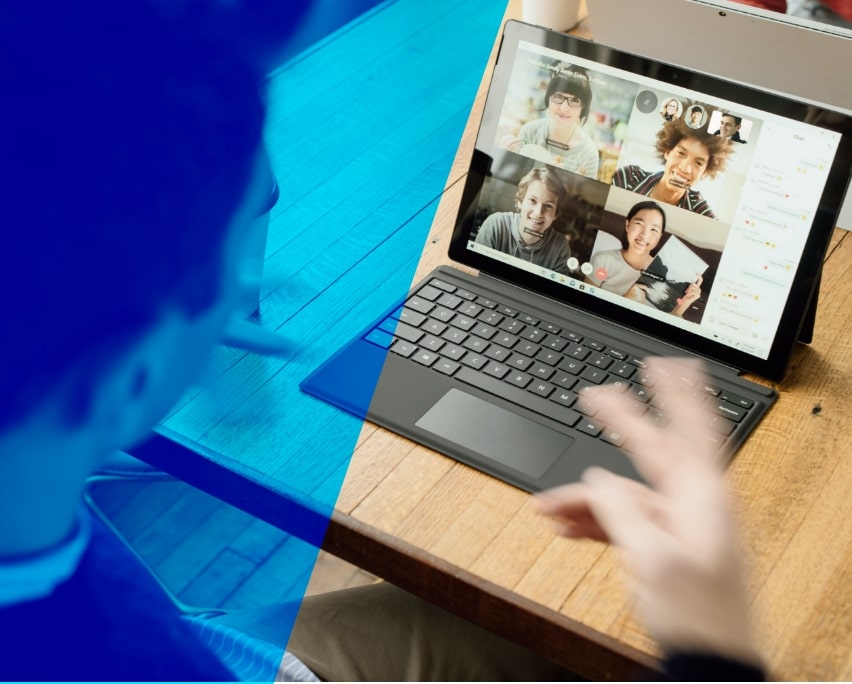Contents
More people are working from home than ever before, and job hunters are asking employers for the flexibility to choose their own workspace. But remote work means remote interviews. Here’s everything you need to know about virtual interviews and starting a new job online.
How remote work has changed job hunting
The COVID-19 pandemic changed everything for remote work. By April 2020, the Office for National Statistics recorded that 44% of workers in Scotland were doing at least part of their job from home.
But the pandemic only accelerated a change that was already happening. As technology has become smarter and faster, remote working is that bit easier for employees and employers. It offers more flexibility and lower costs across the board. In fact, the % of businesses across each country reporting a flexible workspace policy is impressive:
Businesses offering a flexible workspace policy
Germany
Netherlands
Australia
USA
Canada
UK
South Africa
Spain
France
Italy
India
Mexico
China
Japan
Source: Merchant Savvy
With greater freedom and an improved work-life balance, it’s no surprise that almost 97.6% of people currently working remotely say they want to stay remote for at least part of their working hours, according to Vervoe. And 80% of company leaders plan to offer remote work as an option even after the pandemic.
But what happens if you don’t have a remote job yet? What is remote job hunting like? How do virtual interviews and onboarding work? And can you really be more productive working from home?
Before we dive into finding your next remote role, let’s take a quick look at the pros and cons of working – and job hunting – from home.

Remote work and recruitment: the positives
During the pandemic, it’s estimated that almost 24 million people in the UK were working from home. According to Finder, they saved over £1 billion a week between them in commuting costs and buying office lunches. There’s even tax relief available for people who work remotely.
Remote work can save time and money for employers as well. Instead of spending money on expensive office space, they can invest in resources, training, and company growth. There’s also some evidence that remote-friendly companies are more productive and have more loyal staff, according to Review42.
Some of the money saved by employers has been funnelled into software for remote conferencing, collaboration, recruitment, and onboarding. This creates a positive feedback loop where the tech for remote work just keeps getting better.
There are benefits for job seekers, too. You can fit the recruitment process around your own schedule and needs, which makes finding work easier for people with children or caring responsibilities. No wonder that 86% of parents say they want to work flexibly, and “more time with family” is one of the top benefits of remote work according to Visual Capitalist.
Remote interviews can be more accessible for people with disabilities – for example, by using subtitles on a video call if you have a hearing impairment, or enabling someone with mobility problems to join in from home. According to the Office for National Statistics, people with disabilities are 28% less likely to be employed – partly due to a lack of flexible recruitment options and accommodations at work. Virtual interviews and remote work open up new opportunities for people to find jobs that work for them.
What’s more, you don’t have to spend time and money to travel to a remote interview. Remote recruitment even means that you can stay in a rural area, avoiding the high house prices in cities like Glasgow and Edinburgh. That means less expense and upheaval while you switch jobs, and more disposable income once you get started.
But perhaps most importantly, remote interviews are less demanding for everyone involved. You’re at home, on your own turf, where you can feel comfortable and confident.
“I really liked being in my own space,” said one young graduate we spoke to, who found her first job in 2020 after a remote interview. “I found it far less stressful and it meant I could just focus on the interview.”
“I actually found the remote interview process a massive plus,” agreed another successful jobseeker. “It made me feel more relaxed and gave me a few extra seconds to think about my answers.”

Remote work and recruitment: the negatives
However, remote work isn’t always plain sailing.
Some employers worry about productivity when people are working from home. Remote work also raises some security issues: is the company sharing information securely? If someone uses their computer at home, is it protected from hacking and ransomware attacks?
From the job hunter’s point of view, the problems are more personal. It’s harder to get a sense of the atmosphere at a company if you’ve never visited the office or chatted to people in person. There’s no opportunity for the small talk that you have at an in-person interview when you’re waiting in the lobby or getting a coffee. Everything rests on the virtual interview.
Once you start a new job, there’s the challenge of virtual onboarding. You’ll have to make more of an effort to connect with your colleagues and build relationships. Networking in the company can also be more difficult, which is why HR Review reported that some people think remote work could slow down your chances of a promotion or a raise.
For many people, remote work is still worth these potential risks. Everyone has their own priorities for work-life balance, earnings, career progression, and quality of life. But you’ll need to make up the balance. If you go through a virtual interview and onboarding process, you’ll have to work hard to connect with people and make the opportunity work for you.
In the next section, we’ll talk about how to ace a virtual interview, from preparation to following up with companies to get feedback and build connections. Then we’ll take a look at onboarding for remote work.
Is remote work right for you?
Before you commit to working from home, it’s important to think about whether it’s really the right fit for you. Remote work isn’t for everybody, and that’s fine. Ask yourself:
Do you feel confident working alone?
Especially if you’re early on in your career or starting an unfamiliar role, think carefully about whether you have all the skills you need. Remote support will be enough for some people, while others might prefer to learn in the office where there’s plenty of help to hand.
Do you have the right workspace?
That means enough space for your desk, a peaceful place to concentrate, and a good internet connection, as a minimum. The ideal workspace will look different for everyone.
Do you have the right temperament?
Some people love the quiet and concentration of working at home; others miss the buzz and banter of the office. Think about how you like to spend your time. Would you be happy working alone all the time, want the occasional day in the office or a coworking space, or prefer to be in the office full time?
Even if you’re excited to work alone, you’ll still need to build up a support network. Loneliness can hit remote workers hard. In a survey by Small Biz Trends, 20% said that loneliness was the biggest downside to working from home. So you’ll need to be proactive about staying in touch with friends, colleagues, and other remote workers.
How to ace a virtual interview
When you think about a job interview, you probably picture the moment of the interview itself: sitting at a desk, answering questions, and trying to evaluate whether the job seems like a good fit for you.
But there’s a bit more to it than that. If you want to excel at an interview – remote or in person – then there are three different stages to think about.
Stage 01:Preparing for an interview
Stage 02:During the interview
Stage 03:Following up after the interview
It’s important to do well in the interview. But your preparation and follow-up can also make all the difference. Someone who’s great at talking off-the-cuff can still perform badly if they haven’t done their research before an interview. Someone who struggles with confidence during an interview can improve their chances with a great follow-up message.
So let’s go through those steps one by one, starting with how to prepare for a virtual interview.

Stage 01:
How to prepare for a remote interview
The first step is to think about what kind of interview you’re attending. With modern recruitment technology, there are lots of different ways to evaluate candidates, including:
Live, one-to-one interviews
Live group interviews
Hybrid interviews
Where some people attend in person while others call in.
Answering pre-recorded questions on video
Recording a video CV to show off your presentation skills
Live chat interviews, without a video feed
Online skills assessments
These may include a follow-up discussion.
You’ll need to prepare differently depending on the type of virtual interview.
For example, if you have a pre-recorded interview or a skills assessment coming up, then you’ll probably get some tips about which topics to prepare for. In a live interview, you’ll need to be ready to think on your feet. And if you’re asked to record a video CV, then you can practise a few times before you hit “record”.
Next, think about when your interview is scheduled. Try to make sure that the virtual interview is set for a time when:
You’re in a quiet environment with no distractions.
For example, housemates have gone out to work or children are at school
You don’t have anything planned immediately before or after the interview.
So you don’t have to rush!
You’ve had time to eat and drink.
Being hungry or thirsty can affect your performance – you don’t want to be distracted by a rumbling stomach!
If possible, choose a time of day when you know your energy levels will be high.
For some people, this is first thing in the morning; others perk up in the afternoon.
Some remote jobs will involve time zone differences. If you’re interviewing with a company outside Scotland, make sure that you know which time zone they’re using. Ideally, the meeting time should work comfortably for both you and the interviewer.
Now it’s time to do your research. This is what makes really good candidates stand out. Sure, you might have all the skills in the job description. But do you know what makes this job different? What are the company’s history, values, and top clients? What’s the latest topic on their blog? Do they have an email newsletter that you could read? And is there anything in the job description that you’d like to question, clarify, or discuss?
put sticky notes around the computer with any key points or questions you want to cover during the interview.
If you know who is going to interview you, then you can research them too. Search for the names on a professional platform such as LinkedIn to find out more about their experience and interests. Maybe you have a past employer in common, or you both grew up in the same town. You don’t need to get too personal with this research, but a little background information could help you connect with your interviewers.
You can also do a bit of research into yourself. That might sound strange, but in fact, it’s easy to forget what you’ve worked on over the years. Take a few minutes to read through your own CV and cover letter. Be ready to talk about everything that you mentioned, and think about how each point relates to the original job description.
Finally, it’s time to prepare your interview space. Try and do this the day before the interview, so that you have plenty of time to sort out any issues.
Here’s a quick checklist to get you started:
-
Check that your camera and microphone are working correctly.
-
Check that your wifi is working smoothly. If you’re having problems, try tethering your computer to your mobile phone to use a data connection instead. A frozen or time-lagged video call is frustrating for everyone.
-
Look at the feed from your camera. Is the lighting good? Can interviewers see your face clearly? Try to use natural light or cool lighting, rather than warm dim lights.
-
Have the computer positioned so that you are looking into the camera at eye level.
-
Turn off any background noise such as fans or music. If you live on a busy street, close the windows so that you won’t be interrupted by the sound of cars and people going past.
-
Think about your background. You can show some personality, but make sure it isn’t too distracting. Check that the room is clean and tidy. Remove anything that’s too personal or political from the frame.
-
If you don’t feel comfortable letting interviewers see inside your home, you can use a virtual background. Some video platforms also have an option to blur the background slightly.
If you opt for a virtual background, then choose carefully. Recruiters and employers say that they prefer professional backgrounds – so choose the stock photo of an office space over the Star Wars theme.
Because you’re at home, you can also add extra touches to help yourself feel relaxed and prepared.
Make sure that you have some water within easy reach. If you want to refer to the job description or your CV during the interview, then you can have them open as tabs on your computer. Some job candidates we spoke to also recommended putting sticky notes around the computer with any key points or questions you want to cover during the interview.
Having problems? It’s not the end of the world. If you have difficulty finding a quiet room or getting a decent internet connection, then try to let your interviewers know. They may well be sympathetic, or even offer to postpone the interview to a better time.
But if you prepare for your virtual interview in advance, then you should be set up for a smooth experience.

Stage 02:
During a remote interview
Even though the location and the set-up are different, a virtual interview is a lot like an in-person interview. You still need to show up on time, answer questions and make a good impression.
But there are some extra tips for remote interviews, too. Because you’re speaking over an internet connection, it can be harder to hear clearly. Try to speak up and, if you’re a fast talker, maybe even slow down a little so that the interviewer has time to hear and process your answers. Avoid covering your mouth with your hand, which makes it harder to read your expression and hear your words.
Just like in an in-person interview, good eye contact, posture, and a friendly smile can go a long way. You can create the impression of keeping eye contact by positioning your computer with the camera at eye level. Focus on the screen and try not to get distracted.
A recent survey from VisualCV found that 80% of unsuccessful candidates in a video interview seemed distracted. Keeping your gaze on the screen is a way to show interviewers that you are interested and engaged.
According to recruiters, another big problem is candidates who seem to be reading from notes. It’s important to research and prepare, but avoid reading out answers or giving a speech that you’ve rehearsed. If you want to have notes, just write short reminders of key points rather than full sentences.
Finally, you want to avoid any red flags in the interview. Recruiters say that they avoid candidates who:
Lie on their application or during the interview.
Text on their phone during a video call.
Swear or use offensive language.
Dress inappropriately.
Yes, you’re at home – but at least make sure you’re wearing clean, smart clothes.
Talk negatively about their previous employers.
Join the interview without doing any research about the job or the company.
As you can see, you don’t have to learn any fancy techniques or memorise a speech to ace your interview. If you’re on time, focused, polite, and interested, then you’ll get on well.

Stage 03:
Following up after a remote interview
The interview’s over. You’ve answered all the questions, talked about your greatest strengths and weaknesses, and hopefully it’s gone well. Now what?
If you want to make a really good impression on an employer, follow up after the interview. This is especially important if you’re job hunting remotely, because you’ve had fewer opportunities to connect with people in person. You missed out on the casual chat over coffee and the all-important handshake – but you can still make yourself memorable.
After the interview – ideally on the same working day – send a quick email or LinkedIn message to your interviewer. It doesn’t have to be long or eloquently expressed. Just send them a quick thanks for their time, and remind them of how excited you are about the job opportunity.
If you discussed something in particular during the interview (for example, you told them about a project you worked on which seemed especially relevant), then you might send a link so they can follow it up.
Sending a quick thank you note has several benefits:
- It makes you more memorable to the interviewer.
- It shows that you have strong communication skills.
- It opens the door to ask for feedback, even if your job application isn’t successful.
- If you don’t get the job this time, the interviewer might keep you in mind for a future role.
If the interviewer didn’t say when they’d be in touch, this is also a chance to set expectations. Will you hear within the week? Will there be another round of interviews? If there are any questions that you forgot to ask during the interview, now’s your chance.
Starting a new job as a remote worker
Starting a new job as a remote worker can feel like a bit of an anti-climax. You’re all ready to start a new chapter… but you’re still sitting at home, in the same chair, at the same desk.
This is where onboarding comes in. A remote employer should do everything they can to make you feel enthusiastic, welcome and confident in your new role. People working from home face specific challenges:
Because you’re not in a physical office, it can be harder to get to know your colleagues.
You’ll need remote support to get set up with email accounts, software and access to key documents.
You’ll need to know where you can get information or advice if you run into problems.
When you work from home, it’s easy to lose track of your hours. A good remote employer will set clear expectations about how much you should work and how much flexibility you have in creating your routine.
In the next few sections, we’ll talk about what to expect from virtual onboarding; how to get on with your new co-workers; and what to do if something goes wrong.

What to expect from online onboarding
Some remote jobs will still encourage you to come into the office for a few days while you get started. But as employers get used to remote work – and employees take up jobs at even greater distances – online onboarding is becoming the standard.
That’s a good thing. It means that virtual onboarding is becoming a lot more streamlined. More companies are investing in onboarding software, which acts as a one-stop shop to sign paperwork, review training documents, and get reminders about essential tasks.
Virtual onboarding usually includes:
Checking that you have the right hardware to do your job.
Many remote jobs will supply you with your own computer, for example. If you have specific requirements, such as accessibility tech, they should support you with that too.
Setting up software and remote access.
As well as getting your own account and passwords, you may also need training in new software or the standard processes for your job.
Setting up communications.
How does your new team communicate – email, video calls, instant chats? Some remote companies prefer to keep all communications on one platform, while others will use different platforms for different tasks.
Getting to know the team.
Be prepared for a higher frequency of meetings than usual, at least for the first few days or weeks. Your line manager may want to check in each day or after you work on a new task for the first time.
However, according to VisualCV, only 12% of employees say their company is great at onboarding. You’ll need to be proactive about asking for help and getting in touch with colleagues.
Remote work means trading in some benefits (such as easy networking and a clear work/home division) for others (such as more flexible hours). It’s up to you to make sure you’re not missing out. If there’s anything that you’re having problems with, or you feel you’ve missed out on introductions to the team, speak up.
Some remote-focused companies will give you a mentor or a remote buddy to help you settle into the company culture. Even if there isn’t a formal scheme like this in your new job, try to identify a “point person” who will be your go-to for any questions.
How to build connections with your co-workers
Many people love remote work for its independence. But especially at the start of a new job or project, you’ll need to connect with your co-workers for support, ideas, and advice. You can help to build positive connections by being friendly and proactive.
- Use quick communication channels like Slack or Discord to say hi and check in with people. Some teams will have dedicated channels set up for socialising outside of specific work discussions.
- Include friendly greetings in your emails. This might seem like a basic point, but some people do write very short, business-focused messages. It only takes a few extra seconds to be sociable.
- Be ready to introduce yourself quickly on video calls – with a bit of personality! “I’m the new assistant, I’m based in Dundee and I like knitting in my spare time” is a lot more memorable and engaging than just saying “hello everyone”.
“At the last company I worked for, I really appreciated having a daily 10-minute sync about what we were getting up to, as well as weekly coffee chats”
You could also ask if your company has any regular social calls scheduled. For example, some remote offices have a “morning fifteen minutes” where people dial in to drink coffee and chat before they start the day.
“At the last company I worked for, I really appreciated having a daily 10-minute sync about what we were getting up to, as well as weekly coffee chats,” said one remote worker we spoke to. This is an easy way to get to know people outside your immediate team and pick up on the company culture.
Face-to-face meetings can also give you a chance to network, share ideas, and build more effective working relationships. These meet-ups don’t have to be frequent, but they are still an important part of a healthy remote team.
However, it’s worth remembering that people have good reasons for going remote: they may have responsibilities at home or live far from the office. If an employer is encouraging people to meet up in person, they should choose a time during working hours and offer travel expenses if required. That way, no one misses out.
What to do if something goes wrong
However experienced you are, there will always be things to learn in a new job. And when you work remotely, it can seem harder to ask for help. Instead of just casually dropping past someone’s desk, you have to ring them up or write out a message.
But you should never feel shy about asking for help. In a company with a strong remote work culture, you should be encouraged to get in touch whenever you need to.
Right from the start, make sure you have contact details for your line manager and HR department, as well as information about when exactly they’re available. (This is especially important if they work on a flexible schedule or in a different time zone.)

It’s better to collect this information now rather than scrambling to find it in an emergency. If you have a mentor or remote buddy, chat to them early on and find out how they prefer to communicate – a weekly call? Regular emails? Live chat?
You can also look outside your new job for a support network. There’s a strong community of remote workers online who can cheer you on with advice and encouragement. Here are a few places to start:
- Check out local Meetup groups to see if there are any remote work groups near you. They may run regular coffee mornings or co-working sessions. If there isn’t anything near you, why not start a group?
- There may be remote working or work-from-home groups for your area on Facebook or LinkedIn.
- Look for other remote workers in your location or industry on Twitter. Hashtags like #remotework and #wfh are a good place to start.
- Join groups and newsletters for your industry. Even if you can’t meet up in person, you can still keep up with the latest news and network online.
With the right support system in place, you’ll be able to enjoy all the upsides of remote work.







